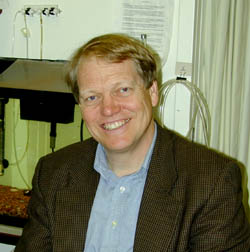| |
| |
| Ralph Nelson, Ph.D., Senior Investigator |
 |
Dr. Nelson received his B.A. in Biophysics from Amherst College and his Ph. D. in Biophysics from Johns Hopkins University. At Johns Hopkins, under the preceptorship of John Dowling, he studied conductance mechanisms responsible for light responses of retinal bipolar cells. In his postdoctoral studies at the National Institutes of Health he formed a close collaboration with Helga Kolb in pioneering a type of study in which the light responses of retinal neurons were tightly interpreted in terms of synaptic connectivity. Dr. Nelson's laboratory is currently investigating the relationship of retinal neuron receptors to processing of visual information in retinal neural circuits.
|

|
Staff:
Research Interests:
The retina is composed of a network of nerve cells which receive, process and transform visual information. Visual information is transduced by photoreceptors and processed by numerous retinal interneurons before transmis The light sensitive tissue at the back of the eye is the retina. sion through optic nerve fibers to brain visual centers. During periods of dim illumination specialized bipolar and amacrine cells selectively process signals from rod photoreceptors. There are other bipolar and amacrine cells which process signals from cone photoreceptors when the visual scene is brightly illuminated. Some neurons are excited by bright contours (ON-center bipolar and ganglion cells). Others are excited by dark contours (OFF-center bipolar and ganglion cells). The goal of studies in the Neural Circuitry Unit is to define systems of neurons devoted to selective visual tasks, and to identify the synaptic mechanisms they employ. A web tutorial on retinal circuitry and function can be found in WEBVISION (below).
Several approaches are employed. One is structure-function studies in retinal slice or whole mount. Photic or drug induced responses are compared to morphology and synaptic connectivity of retinal neurons. Acutely dissociated retinal neurons provide another approach. Dissociated horizontal and bipolar cells can be recognized morphologically, and pharmacological reactions studied with fluorescent probes. The zebrafish model has been employed in recent studies defining glutamate mechanisms used in ON and OFF bipolar cells.
|
Selected Recent Publications:
Connaughton, V. P., Graham D., and Nelson R. (2004) Identification and morphological classification of horizontal, bipolar, and amacrine cells within the zebrafish retina. , J. Comp. Neurol 477, 371-385.
Nelson, R. Bender, A. M. and Connaughton, V. P. (2003) Stimulation of sodium pump restores membrane potential to neurons excited by glutamate in zebrafish distal retina, J. Physiol 549, 787-800.
Nelson, R., Janis A. T., Behar T. N. and Connaughton V. P. (2001) Physiological Responses Associated with Kainate Receptor Immunoreactivity in Dissociated Zebrafish Retinal Neurons: a Voltage Probe Study. In H. Kolb and S. Wu editors: "Concepts and Challenges in Retinal Biology: A Tribute to John E. Dowling", Progress in Brain Research 131, 255-265.
Kolb, H., Nelson, R., Ahnelt, P. and Cuenca, N. (2001) Cellular organization of the vertebrate retina. In H. Kolb and S. Wu editors: "Concepts and Challenges in Retinal Biology: A Tribute to John E. Dowling", Progress in Brain Research 131, 3-26.
All Selected Publications
Contact Information:
Dr. Ralph Nelson
Neural Circuits Unit
Basic Neurosciences Program, NINDS
5625 Fishers Lane
Bethesda, MD 20892-
Telephone: (301) 496-8133 (office),
(301) 496-8133 (laboratory),
(301) 496-1565 (fax)
Email: rnelson@codon.nih.gov
|
|















